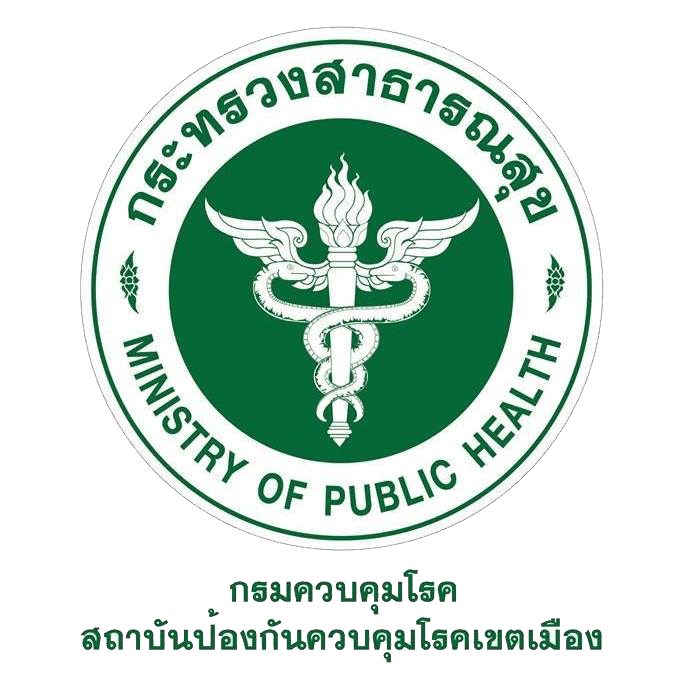ปัจจัยที่สัมพันธ์กับการติดเชื้อโควิด 19 แบบกลุ่มก้อนในบุคลากรทางการแพทย์ ระลอกที่ 1 พื้นที่กรุงเทพมหานคร
Main Article Content
บทคัดย่อ
บทคัดย่อ
บุคลากรทางการแพทย์และสาธารณสุขเป็นกลุ่มเสี่ยงสูงที่มีโอกาสติดเชื้อไวรัสโคโรนา 2019 (COVID - 19) โดยเฉพาะในการระบาดระลอกที่ 1 ซึ่งทั่วโลกรวมถึงประเทศไทยที่ยังขาดองค์ความรู้เกี่ยวกับโรค COVID - 19 ที่ชัดเจนเพียงพอในการป้องกันการติดเชื้อที่เป็นแบบกลุ่มก้อนและรายบุคคล การศึกษานี้มีวัตถุประสงค์เพื่อศึกษาปัจจัยที่สัมพันธ์กับการติดเชื้อไวรัสโคโรนา 2019 แบบกลุ่มก้อนของบุคลากรทางการแพทย์และสาธารณสุข ในพื้นที่กรุงเทพมหานคร วิธีการศึกษาแบบภาคตัดขวาง ในกลุ่มบุคลากรทางการแพทย์ที่ให้บริการในสถานพยาบาลที่ติดเชื้อโรค COVID – 19 รวบรวมข้อมูลจากแบบสอบสวนผู้ป่วยโรคติดเชื้อไวรัสโคโรนา 2019 (Novel corona 2) โดยทีมสอบสวนโรคของสถาบันป้องกันควบคุมโรคเขตเมืองมีจำนวน 75 ราย วิเคราะห์ข้อมูลด้วยสมการถดถอยพหุ ผลการศึกษา พบว่า ผู้ติดเชื้อทั้งหมด 75 ราย เป็นการติดเชื้อแบบกลุ่มก้อน 47 ราย (ร้อยละ 62.7) ทั้งหมด 3 กลุ่มก้อน ในโรงพยาบาลเอกชนทั้งหมด ติดเชื้อรายบุคคล 28 ราย (ร้อยละ 37.3) ปัจจัยเสี่ยงที่สัมพันธ์กับรูปแบบการติดเชื้อแบบกลุ่มก้อนเมื่อควบคุมอิทธิพลของอายุ พบว่า การทำงานในแผนกผู้ป่วยใน (ORadj = 6.66 , 95%CI 1.47-30.19) เมื่อเปรียบเทียบกับแผนกสนับสนุน สำหรับกลุ่มการทำงานในแผนกผู้ป่วยนอก/ฉุกเฉิน ยังไม่สามารถสรุปได้ว่าเป็นกลุ่มเสี่ยง (ORadj = 1.09 95%CI 0.24 – 5.02) ทั้งนี้พบว่ากลุ่มที่ติดเชื้อแบบกลุ่มก้อน มีการใส่อุปกรณ์ป้องกันไม่ถูกต้อง/ไม่เหมาะสม ร้อยละ 53 ดังนั้นการป้องกันการติดเชื้อแบบกลุ่มก้อนของบุคลากรทางการแพทย์และสาธารณสุขจึงควรให้ความสำคัญในการสวมใส่อุปกรณ์ป้องกันส่วนบุคคลอย่างถูกต้องและมีการให้ความรู้การฝึกปฏิบัติการใส่อุปกรณ์ป้องกันส่วนบุคคลอย่างสม่ำเสมอ
Article Details

อนุญาตภายใต้เงื่อนไข Creative Commons Attribution-NonCommercial-NoDerivatives 4.0 International License.
บทความที่พิมพ์ในวารสารสถาบันป้องกันควบคุมโรคเขตเมือง ถือว่าเป็นผลงานวิชาการ งานวิจัยและวิเคราะห์ ตลอดจนเป็นความเห็นส่วนตัวของผู้เขียนเอง ไม่ใช่ความเห็นของสถาบันป้องกันควบคุมโรคเขตเมือง หรือคณะบรรณาธิการแต่ประการใด ผู้เขียนจำต้องรับผิดชอบต่อบทความของตน
เอกสารอ้างอิง
Mingkun Z, Yaxun Q, Xiang X, Zhu S. Death from Covid-19 of 23 Health Care Workers in China. The New England Journal of Medicine. 2020;382(23):2267-2268.
International Council of Nurses. High proportion of healthcare workers with COVID-19 in Italy is a stark warning to the world: protecting nurses and their colleagues must be the number one priority [Internet]. 2020 [Cited 2021 Dec 12] available from: https://www.icn.ch/news/high-proportion-healthcare-workers-covid-19-italy-stark-warning-world-protecting-nurses-and
สายศิริ ด่านวัฒนะ, รวีพร สาแสนทอง, อำนวยพร เอี่ยมพันธ์, สุภาวัลย์ จำปาหอม. ปัจจัยที่เกี่ยวข้องกับพฤติกรรมล้างมือและใช้อุปกรณืการควบคุมและป้องกันการแพี่กระจายเชื้อในโรงพยาบาลของบุคลากรทางการแพทย์และศึกษาการรับรู้ของสื่อมวลชนต่อปัญหาเชื้อดื้อยา เพื่อวางแผนสื่อสารเพื่อปรับพฤติกรรมและการสื่อสารสาธารณะ.สถาบันวิจัยระบบสาธารณสุข. 2556:4.
Annelies WS, Monica DT, Bee HH, Arul E, Ai EL, Yee SL. Asymptomatic SARS Coronavirus Infection among Healthcare Workers, Singapore. Emerging Infectious Disease. 2005;11(7):1142-5.
Chaovavanich A, Wongsawat J, F Dowell S, Inthong Y, Sangsajja C, Sanguanwongse N, et al. Early Containment of Severe Acute Respiratory Syndrome (SARS); Experience from Bamrasnaradura Institute, Thailand. Journal of the Medical Association of Thailand. 2004;87:1182.
World Health Organization Thailand [Internet]. กรุงเทพมหานคร: สำนักงาน; c2020. COVID-19 - WHO Thailand Situation Reports รายงานสถานการณ์โรคโดยองค์การอนามัยโรคประจำประเทศไทย ฉบับที่ 68; 2563 [เข้าถึงเมื่อ 12 สิงหาคม 2565]; [ประมาณ 2 หน้า]. เข้าถึงได้จาก https://cdn.who.int/media/docs/default-source/searo/thailand/2020-05-01-tha-sitrep-69-covid19-th.pdf?sfvrsn=11dff472_2
ปริตตา หวังเกียรติ. Hfocusเจาะลึกระบบสุขภาพ [อินเทอร์เน็ต]. กรุงเทพมหานคร: สำนักข่าว Hfocus เจาะลึกระบบสุขภาพ; 2563. บุคลากรการแพทย์ติดเชื้อโควิด -19 เหตุขาดแคลนอุปกรณ์ป้องกัน; 2563 [เข้าถึงเมื่อ 12 สิงหาคม 2565]; [ประมาณ 3 หน้า]. เข้าถึงได้จาก https://www.hfocus.org/content/2020/04/18981
Wang D, Hu B, Hu C, Zhu F, Liu X, Zhang J, et al. Clinical Characteristics of 138 Hospitalized Patients With 2019 Novel Coronavirus–Infected Pneumonia in Wuhan, China. JAMA. 2020;323(11):1061-9.
กรมควบคุมโรค กระทรวงสาธารณสุข [อินเทอร์เน็ต]. นนทบุรี: สำนักงาน; 2563. การจัดการทางด้านอาชีวอนามัยและการสอบสวนโรคติดเชื้อไวรัสโคโรน่า 2019 ในบุคลากรสุขภาพ, 2563 [เข้าถึงเมื่อ 12 สิงหาคม 2565]; [ประมาณ 34 หน้า]. เข้าถึงได้จาก https://ddc.moph.go.th/uploads/publish/1009920200514024417.pdf
สหคลินิกเมดิคอลไลน์ แล็บ (บริษัท เมดิคอลไลน์ แล็บ) [อินเทอร์เน็ต]. กรุงเทพมหานคร: สำนักงาน; 2564. อัปเดต ‘สายพันธุ์โควิด-19’ ในไทย พร้อมเช็คอาการเบื้องต้นของแต่ละสายพันธุ์. 2564 [เข้าถึงเมื่อ 12 ม.ค. 2565]. เข้าถึงได้จาก: https://www.medicallinelab.co.th/%E0%B8%9A%E0%B8%97%E0%B8%84%E0%B8%A7%E0%B8%B2%E0%B8%A1/%E0%B8%AD%E0%B8%B1%E0%B8%9B%E0%B9%80%E0%B8%94%E0%B8%95-%E0%B8%AA%E0%B8%B2%E0%B8%A2%E0%B8%9E%E0%B8%B1%E0%B8%99%E0%B8%98%E0%B8%B8%E0%B9%8C%E0%B9%82%E0%B8%84%E0%B8%A7%E0%B8%B4%E0%B8%94-19-%E0%B9%83/
พันธนีย์ ธิติชัย, ภันทิลา ทวีวิกยการ. รายงานผลการทบทวนสถานการณ์โรคโควิด-19 และมาตรการควบคุมป้องกันในระดับโลก และในประเทศไทย. นนทบุรี: กลุ่มเทคโนโลยีและระบาดวิทยา กองโรคไม่ติดต่อ กรมควบคุมโรค; 2564.
กระทรวงสาธารณสุข [อินเทอร์เน็ต]. กรุงเทพมหานคร: สำนักงาน; 2564. 10 ตัวชี้วัดสุขภาพคนไทย. 2563 [เข้าถึงเมื่อ 12 ม.ค. 2565]. เข้าถึงได้จาก: https://hss.moph.go.th/fileupload_doc_slider/2016-12-08--465.pdf
กนก เรืองนาม. การศึกษาเปรียบเทียบการให้บริการระหว่างโรงพยาบาลรัฐและโรงพยาบาลเอกชน. วารสารวิทยาลัยนครราชสีมา. 2558;9(2):64-75.
Saad MM, Molaeb BS, Almoosa ZA, Mahmoud F, Sureendran B, Maranon C, et al. Clustering of Covid-19 infections among healthcare workers: Experience from a tertiary care center in Saudi Arabia. Am J Infect Control
. 2022 Sep;50(9):981-87.
Artiga S, Rae M, Pham O, Hamel L, Muñana C. COVID-19 Risks and Impacts Among Health Care Workers by Race/Ethnicity. Kaiser Family Foundation. 2020.
Gholami M, Fawad I, Shadan S, Rowaiee R, Ghanem H, Khamis AH, et al. COVID-19 and healthcare workers: A systematic review and meta-analysis. International Journal of Infectious Diseases. 2021;104:335-46.
Oran DP, Topol EJ. Prevalence of Asymptomatic SARS-CoV-2 Infection. Annals of Internal Medicine. 2020;173(5):362-7.
Chow PKH, Ooi E-E, Tan H-K, Ong K-W, Sil BK, Teo M, et al. Healthcare worker seroconversion in SARS outbreak. Emerging infectious diseases. 2004;10(2):249-50.
Zhao D, Wang M, Wang M, Zhao Y, Zheng Z, Li X, et al. Asymptomatic infection by SARS-CoV-2 in healthcare workers: A study in a large teaching hospital in Wuhan, China. International Journal of Infectious Diseases. 2020;99:219-25.
Stokes EK, Zambrano LD, Anderson KN ea. Coronavirus Disease 2019 Case Surveillance — United States, January 22–May 30, 2020. MMWR Morb Mortal Wkly Rep. 2020;69(24):759-765.
Eurosurveillance editorial team. Updated rapid risk assessment from ECDC on coronavirus disease 2019 (COVID-19) pandemic: increased transmission in the EU/EEA and the UK. Euro Surveill. 2020;25(12).
European Centre for Disease Prevention and Control [Internet]. Stockholm: ECDC. 2020- [update 2020 March 25; cite 2022 Aug 12]. Available from: https://www.ecdc.europa.eu/sites/default/files/documents/RRA-seventh-update-Outbreak-of-coronavirus-disease-COVID-19.pdf
Kluytmans-van den Bergh MFQ, Buiting AGM, Pas SD, Bentvelsen RG, Bijllaardt WVD, Oudheusden AJGV, et al. Prevalence and Clinical Presentation of Health Care Workers With Symptoms of Coronavirus Disease 2019 in 2 Dutch Hospitals During an Early Phase of the Pandemic. JAMA Network Open. 2020;3(5):e209673.
Ran L, Chen X, Wang Y, Wu W, Zhang L, Tan X. Risk Factors of Healthcare Workers with Corona Virus Disease 2019: A Retrospective Cohort Study in a Designated Hospital of Wuhan in China. Clinical Infectious Diseases. 2020; 71(16):2218-21.


